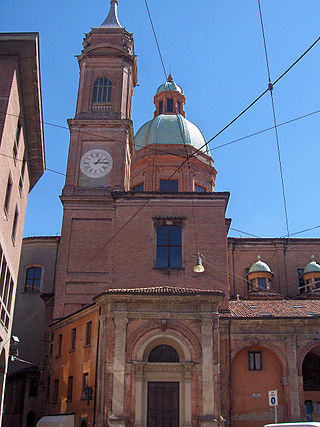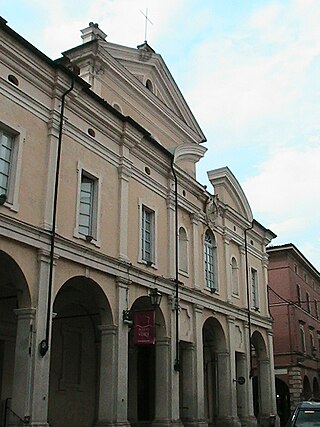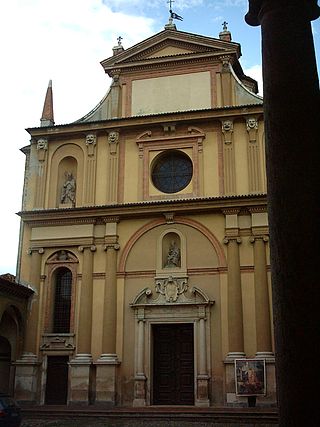

The Collegiate Church of St Florentius (Italian: Collegiata San Fiorenzo) is a Gothic style, Roman Catholic collegiate, now parish church, in Fiorenzuola d'Arda, in the Province of Piacenza, region of Emilia-Romagna, Italy.


The Collegiate Church of St Florentius (Italian: Collegiata San Fiorenzo) is a Gothic style, Roman Catholic collegiate, now parish church, in Fiorenzuola d'Arda, in the Province of Piacenza, region of Emilia-Romagna, Italy.
A church at the site, dedicated to St. Boniface, was present here in 824; later documents note a church dedicated to St. Fiorenzo was rebuilt here in 1273. [1] The Romanesque crypt still maintains an altar dedicated to St Boniface. However construction was not accelerated until 1485. The interior chapel of the Santissimo Sacramento was built in 1685 in Baroque style. [2]
The apse, presbytery, and nave have frescoes mainly focused on the Life of San Fiorenzo by 15th century artists. The stuccoes in the Chapel of the Holy Sacrament were complete by Giacomo Marcori in 1681, and frescoed by Bartolomeo Baderna. It contains a painting depicting the Parable of the Convict (1668) by Jacopo Ferrari, and on the walls two canvases (1674-1675) by Pietro Galli. The 18th-century main altar was designed by Giovanni Paolo Panini and completed by Giovanni Maria Bignetti in 1741. The third altar on the left has a painting depicting the Miracle of San Fiorenzo (1741) by Marco Benefial.
The central pilaster have fragments of frescoes from 1520 and earlier depicting the Madonna. The ciborium dates from the late 11th-century. The organ (1733) built by Giovanni Domenico Traeri was frescoed in the 15th century. The church also has paintings by Giovanni Battista Natali and Antonio Alessandri. [3] [4]
Not far from the church is the Oratory della Buona Morte with an oval cupola. [4]

The Basilica of San Petronio is a minor basilica and church of the Archdiocese of Bologna located in Bologna, Emilia Romagna, northern Italy. It dominates Piazza Maggiore. The basilica is dedicated to the patron saint of the city, Saint Petronius, who was the bishop of Bologna in the fifth century. Construction began in 1390 and its main facade has remained unfinished since. The building was transferred from the city to the diocese in 1929; the basilica was finally consecrated in 1954. It has been the seat of the relics of Bologna's patron saint only since 2000; until then they were preserved in the Santo Stefano church of Bologna.

Fiorenzuola d'Arda is a city and comune in Italy in the province of Piacenza, part of the Emilia-Romagna region. Its name derives from Florentia. The "d'Arda" portion refers to the River Arda which flows from the Apennines into the valley where Fiorenzuola is situated. Fiorenzuola's origins are old, dating from the first prehistorical human settlements in Italy.

Castell'Arquato is an Italian town located on the first hills of Val D’Arda in the province of Piacenza, in Emilia-Romagna, approximately 30 kilometres (19 mi) from Piacenza and 35 kilometres (22 mi) from Parma. Places nearby include Bacedasco, Vigolo Marchese, Fiorenzuola d'Arda, Lugagnano Val d'Arda, and Vernasca. It is a member of the I Borghi più belli d'Italia association.
Cortemaggiore is an Italian comune located in the Province of Piacenza. Cortemaggiore is located in northern Italy about 80 kilometres (50 mi) from Milan and 120 kilometres (75 mi) from Bologna, in the Pianura Padana. The municipality borders Fiorenzuola d'Arda, Villanova sull'Arda, Besenzone, San Pietro in Cerro, Caorso, Pontenure and Cadeo.

The Tempio della Beata Vergine della Ghiara, also known as Basilica della Madonna della Ghiara, is a church in Reggio Emilia, northern Italy. The building is the property of the comune (municipality) of the city.

The Shrine of Santa Maria della Steccata is a Greek-cross design Renaissance church in central Parma, Italy. The name derives from the fence in the church. A Nursing Madonna is enshrined within, crowned on 27 May 1601 by a Marian devotee, Fray Giacomo di Forli of the Capuchin order. Pope Benedict XVI raised the Marian sanctuary to the status of Basilica minor on 9 February 2008.

Santi Bartolomeo e Gaetano is a Renaissance style, Roman Catholic church in central Bologna; it is located near the Due Torri adjacent to the Strada Maggiore.

San Martino church, also called San Martino Maggiore is a Gothic-style, Roman Catholic church located at the corner of Via Marsala and Via Guglielmo Oberdan in Bologna, region of Emilia Romagna, Italy. The church was founded by the adjacent Carmelite monastery. On 10 August 1704 via the authority of the Vatican Chapter, the venerated image of the Virgin of Mount Carmel was crowned by Pope Clement XI. On 25 August 1941, Pope Pius XII elevated it to the status of basilica.

The Basilica of San Fedele in Como is located in the city center. The present Romanesque church dates from 1120 and is dedicated to the Fidelis of Como.
Santa Maria della Carità is a Renaissance-style Roman Catholic church in central Bologna, Italy.

Sant'Ignazio is a Baroque architecture-style Roman Catholic church, located in Busseto, region of Emilia-Romagna, Italy.

The Collegiata di Castell'Arquato, also known as the Collegiata di Santa Maria, is a Romanesque-style, Roman Catholic church located in the Castell'Arquato, province of Piacenza, in Emilia-Romagna, Italy.
San Pietro is a Roman Catholic church in central Piacenza, Emilia Romagna, Italy. The church was built over the site of an ancient church titled San Pietro in Foro.

San Sisto is a Renaissance style, Roman Catholic church, located in Piacenza, Region of Emilia Romagna, Italy.

The Church of the Theatines (Teatini), also known as Santa Maria della Pietà is a Roman Catholic, Baroque-style church and monastery located on Corso della Giovecca, in central Ferrara, region of Emilia-Romagna, Italy.

The Basilica of Santa Maria delle Grazie or Collegiata is a Gothic style, Roman Catholic church and cathedral of Cortemaggiore, in the Province of Piacenza, region of Emilia-Romagna, Italy.

San Germano e San Giovanni Bosco is the 20th-century Roman Catholic parish church of Podenzano, Province of Piacenza, region of Emilia-Romagna, Italy.

San Bartolomeo is a Gothic-style, Roman Catholic collegiate church located in Busseto, in the Italian region of Emilia-Romagna.
San Francesco is a Roman Catholic church located on Via Emilia in the town of Castelbolognese, in the region of Emilia Romagna, Italy.
San Nicola di Bari is Roman Catholic parish church located in the town of Sestola in the region of Emilia-Romagna, Italy.